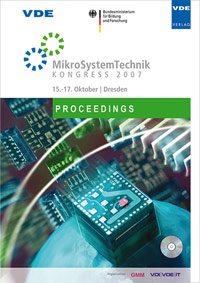Tailormade surfaces for a guided adhesion and outgrowth of cells
Konferenz: MikroSystemTechnik - KONGRESS 2007
15.10.2007 - 17.10.2007 in Dresden, Germany
Tagungsband: MikroSystemTechnik
Seiten: 4Sprache: EnglischTyp: PDF
Persönliche VDE-Mitglieder erhalten auf diesen Artikel 10% Rabatt
Autoren:
Wörz, Anke; Berchtold, Bernd; Rühe, Jürgen (IMTEK – Institute of Microsystems Engineering, Laboratory for Chemistry and Physics of Interfaces, University of Freiburg, Georges-Köhler-Allee 103, D-79110 Freiburg)
Kandler, Steffen; Wörz, Anke; Prucker, Oswald; Egert, Ulrich; Aertsen, Ad; Rühe, Jürgen (BCCN – Bernstein-Center for Computational Neuroscience, University of Freiburg, Hansastrasse 9a, D-79104 Freiburg)
Kandler, Steffen; Egert, Ulrich; Aertsen, Ad (Institute of Biology III – Neurobiology and Biophysics, University of Freiburg, Schänzlestrasse 1, D-79104 Freiburg)
Inhalt:
In the field of biomedicine and biotechnology the spatial control over cell adhesion on material surfaces has become a subject in many applications. For instance, due to a specific surface coating cells can be confined to selected areas of a biosensor for pharmaceutical testing. Likewise, the control of the adhesion of neuronal cells on the sensitive spots of an extracellular recording device combined with a directed neuronal outgrowth on pathways, along which these neurons can interconnect, allows highly defined experiments on cellular interactions, network behavior, and neurocomputing and may provide a tool for the creation of neurological implants and their insertion into the host tissue. To allow the successful integration of cells into defined areas of artificial materials, the physicochemical properties of surfaces have to be controlled. A simple way is to tailor the surfacechemistry by using a photochemical approach, which allows the covalent attachment of polymers to surfaces containing self assembled monolayers of photoactive benzophenone moieties. Using this process a variety of different polymer coatings can be prepared both, surface-attached polymer films that support the adhesion and outgrowth of living cells as well as stable surface coatings that prevent the attachment of living cells. Microstructuring of the polymer layers can be carried out by using a simple ablation technique, which selectively removes the polymer, by using a contact printer or a μ-contact printing technique.


